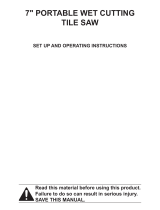
MK Diamond Products Inc. Customer Service Department (800) 421-5830
MK-145 Revision 09/04, Effective date – September 23, 2004 Page
7
SAFETY:
Sawing and drilling generates dust. Airborne dust particles may cause irritation to eyes,
skin and respiratory tract. To avoid breathing impairment, always employ dust controls and
protection suitable to the material being sawed or drilled; See OSHA (29 CFR Part
1910.1200). Diamond Blades improperly used are dangerous. Comply with American
National Standards Institute Safety Code, B7.1 and, Occupational Safety and Health Act
covering Speed, Safety Guards, Flanges, Mounting Procedures, General Operating Rules,
Handling, Storage and General Machine Conditions.
CALIFORNIA PROPOSITION 65 MESSAGE:
Some dust created by power sanding, sawing, grinding, drilling, and other construction
activities contain chemicals known [to the State of California] to cause cancer, birth defects
or other reproductive harm. Some examples from an extensive list of potentially harmful
chemicals include:
• Lead, from lead-based paints
• Crystalline silica, from bricks and cement and other masonry products and
• Arsenic and chromium, from chemically treated lumber
Your risk from these exposures varies depending on how often you do this type of work.
To reduce your exposure to these chemicals, work in a well-ventilated area, and work with
approved safety equipment, such as those dust masks that are specially designed to filter
out microscopic particles. Such dust masks are available at most hardware stores.
Carefully read the instructions that accompany the dust masks to determine appropriate
use and applications.
ELECTRICAL REQUIREMENTS AND GROUNDING INSTRUCTIONS:
In order to prevent potential electrical shock and injury, the following electrical safety
precautions and symbols should be followed at all times!
In case of a malfunction or breakdown, grounding provides a path of least resistance for
electric current to reduce the risk of electric shock. This tool is equipped with an electric
cord having an equipment-grounding conductor and a grounding plug. The plug must be
plugged into a matching outlet that is properly installed and grounded in accordance with
all local codes and ordinances.
• Do not modify the plug provided – if it will not fit the outlet, have the proper outlet
installed by a qualified electrician
• Improper connections of the equipment-grounding conductor can result in a risk of
electric shock. The equipment-grounding conductor is the insulated conductor that has
an outer surface that is green with or without yellow stripes. If repair or replacement of
the electric cord or plug is necessary, do not connect the equipment-grounding
conductor to a live terminal
• Do not use adaptors to bypass the 3-prong grounding plubs.
• Check with a qualified electrician or service personnel if the grounding instructions are
not completely understood, or if in doubt as to whether the tool is properly grounded
• Use only 3-wire extension cords that have 3-prong grounding plugs and 3-pole
receptacles that accept the tool's plug
• Repair or replace damaged or worn cord immediately

































